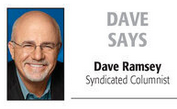Records provide amazing window into past
Published 8:42 am Saturday, June 13, 2020
By BRENDA S. EDWARDS
Contributing writer
(Editor’s note: Information in this article was taken from an article written in 1884 by John W. Yerkes and published in The Advocate-Messenger. Yerkes (1844-1922), a native of Danville, was a Centre College graduate. He was an attorney in Danville and Washington, D.C., master commissioner of the Boyle Circuit and U.S. Commissioner of the Internal Revenue Service. He was chairman of the Boyle County Republican Party and served as the GOP Convention representative in 1895. He also ran for governor in 1900 and was defeated by a narrow margin.)
Boyle County court records are the memorials of our local organization, the register of our first county officials, the annals of their acts; and even a careless examination of these books has proven so entertaining to the writer that a desire has been begotten for more information.
Yerkes wrote about the characters, entertainments, habits and even the vagaries of eccentricities, if any, of these men who blazed the way of succeeding officials.
He wrote with the hope that the statement of a few facts found in the books, with names and brief mention of those participating, would stir up some of the still living witnesses of the beginning of the Boyle County life, and who aided in her birth.
Also, those who have treasured up in their memories many “rich fragments of local and personal history” relating to that period, to preserve knowledge and the recollections in some enduring form for the study and entertainment of their children, and not commit such reminiscences to the unreliable and uncertain custody of oral tradition.
The act of establishing Boyle County was approved by the governor on Feb. 15, 1842. On March 14, 1842, the following were named to justices of peace by Gov. Robert P. Letcher during an organized meeting in the Tavern House of Nelson Shields in Danville: James P. Mitchell, Foushee T. Taylor, Michael G. Youce, Thomas Downton, Nelson Mays, George T. Kirkland, Obadiah Garnett, Abrams Fulkerson, James S. Hopkins, John Henderson, Charles Henderson, Issachar P. Fisher, and James Woodson Burton.
Mitchell was qualified as a justice before Squire Taylor of Marion County on March 2, who administered that oath to the new justices.
The tavern house referred to is with but few changes and additions to what we now know as the Central House or the old Sneed House.
In the old days of the town, before the courthouse was built, political candidates usually spoke from the rear porch of the house, a wide hallway then running through the building from a street entrance to the back yard. The audience assembling in the yard, which was nicely set in grass, spoke from the porch.
The 13 justices were, without exception, men of influence, high character and honorable standing, industrious, painstaking in the discharge of their duties; and of them have rested from their labors and joined the silent majority except 70-year-old Woodson Burton, who is known as one of our active, hard-riding businessmen.
The people of our county gave expression to their approval of these gentlemen by electing them to various positions of trust.
Hoskins was Boyle’s first representative in the state legislature, John Payne Mitchell as the third and Garnett as the fourth representative.
Mitchell also was sheriff and three times county judge. He was a man of strong mind, keen and quick perception, of fine humor, large hearted, always in sympathy with the people and all projects to benefit them.
To Mitchell more than any other one man we are indebted for the broad roads and turnpikes which thread our county and have added so materially to the value of the land and comfort of the people.
Magistrate Henderson
Charles Henderson was a magistrate for several years and in a small frame room standing on the grounds now occupied by the rear of Gentry & Whitley’s store house, he administered stern justice. In his court the plea of limitation or infancy was not allowed to obstruct the collection of an acknowledged debt.
During a temperance movement in Danville, a prisoner brought into court, charged with being drunk, a crime especially heinous and obnoxious just at that time. The defendant proved he had been in town six hours, was sober when he arrived and had not taken a drink since he arrived, and that his rocking walk was natural.
The squire said the defendant might perhaps be sober, but he looked like a man who, if left to himself, would be drunk before he left town, so he would, as a warning, fine him one dollar and costs.
Henderson accumulated a large amount of property and expended a good part of it in building store houses on Main and Third streets.
A tale handed down about Squires Downton and Youce said Constable George Doneghy arrested a man who lived in the knobs and was known and liked by everyone, and whose only fault was the fondness of this cup.
After hearing the case, the squires told the man if he would make up a rhyme, they would order his release. The man responded:
“Squire Downton and Squire Michael Youce,
The two ugliest men in the house,
An ugly constable standing by
Whose name is George W. Doneghy.” He was released.
Doneghy was one of the first constables named for Boyle County and later became tax commissioner and sheriff.
He was emphatically “the people’s candidate and the poor man’s friend” to the day of his death.
Abram L. Caldwell was also an early sheriff. He was a man of the highest integrity, had a commanding influence in the county, and was elected state senator in 1851. He lived on a farm north of Danville that was later occupied by John Yeiser.
Dr. Duff Green, a brother of Lewis Green, was county clerk. He resigned his office in 1844 and moved to Illinois.
First lawyers
The first lawyers admitted to practice in Boyle County Court were Joshua F. Bell, Jeremiah T. Boyle and James Barbour, who took the oath before the justices on March 14, 1842, in the tavern house. The first order was to appoint Jeremiah T. Boyle as county attorney.
The Boyle bar traces back to no mean ancestry — broad legal attainments, professional preferment, eloquence, statesmanship, bells-letters, kindliness of heart, christian worth, business, political and military success are represented by the three names.
Of them, Bell and Boyle passed from the activity of life to the repose of death, and even a sketch of their lives in connection without the county’s history, would stretch out far beyond the limits of a newspaper article.
Barbour moved to Maysville, and was a senior member of a strong law firm, president of a bank, and largely interested in the railroad enterprises of that city. His tall, commanding figure is annually seen on our streets during college commencement, and no one has more interesting events to tell of the old days than he.
Lapse of time, change of residence, and press of business have failed to efface from the tablets of his memory even the memory even the minutiae, and what some would call the trifles, of occurrences.
But his beard is fast frosting, and no doubt he finds more familiar names under the pine trees of our cemetery than he sees familiar faces on our streets.
Rules adopted by the first justices show they were closely observant of decorum and punctilio, and had a fine sense of the proprieties of things.
Rule 5 states that any member of the court wishing to address the court shall rise to his feet and address the presiding justice and Rule 7 states the court shall appoint no one to office who engages in the practice of electioneering and tampering with members of the court for such appointment.
Entertainment places
Two principal houses of entertainment in 1842 were the tavern house of Nelson Shields, and a hotel kept by James Porter on the corner occupied by the Clemens House.
Whether or not these two hosts needed regulating, but on April 11, 1842, the County Court, with due regard to the purse of the wayfaring man and the stranger, and following the common custom of the day, fixed by an order on their books, the following tavern rates:
“Breakfast, dinner and supper 25 cents each; and 12.5 cents each for lodging, horse feed, brandy, wine, rum, gin and whiskey.
In 1842, the prices were increased for liquors which cost 15 cents per drink, while the price of a meal is 50 cents.





